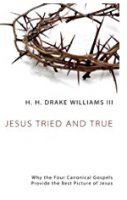Drake Williams, professor of New Testament language and literature at Tyndale Theological Seminary in the Netherlands, compares the canonical Gospels with the non-canonical gospels and concludes that the canonical Gospels are superior in terms of their earlier dating, their dependence upon eyewitness testimony, and their reception and use by the earliest Christians. Williams devotes one chapter to each of these metrics and a fourth chapter to a closer examination of the most popular non-canonical gospels. A concluding chapter summarizes the evidence and discusses the value of the non-canonical gospels.
Chapter one examines the dates of the canonical and non-canonical gospels with the working presupposition that gospels written closer in time to Jesus’ life likely contain more historically reliable information about Jesus. Williams, in line with scholarly consensus, dates each of the canonical Gospels to the latter half of the first century. By comparison, he provides lists of the dates assigned to the non-canonical gospels from Paul Foster, Bart Ehrman, and Craig Evans. Most scholars assign these gospels to various dates in the second century because of their connection with Gnosticism and their dependence upon the canonical Gospels. Williams provides a fuller examination of the dating of the Gospel of Thomas and the Gospel of Peter since some scholars date these gospels to the first century. After a nine page discussion he concludes that both of these gospels were composed in the second century. In terms of dating, the canonical gospels provide the earliest written testimony to the historical Jesus.
Chapter two examines the sources of the canonical and non-canonical gospels with the working presupposition that gospels which contain verifiable eyewitness testimony should be preferred to gospels which have no connection to the original eyewitnesses. The heart of this chapter summarizes Richard Bauckham’s influential book Jesus and the Eyewitnesses: The Gospels as Eye-Witness Testimony (Grand Rapids: Eerdmans, 2006). Williams discusses internal explicit and implicit evidence that the canonical Gospels are dependent upon eyewitnesses (explicit claims, the twelve disciples, named individuals), the titles on the Gospels, and the external evidence from the fragments of Papias. He concludes that in each of these areas the canonical gospels demonstrate dependence on eyewitness testimony while there is little evidence of such dependence within the non-canonical gospels. The non-canonical gospels are thus inferior and less likely to provide reliable information about Jesus than the canonical gospels.
Chapter three evaluates the gospels based upon their reception by the earliest Christians: the Apostolic Fathers (dated between AD 70–135), Justin Martyr, the Muratorian Canon, and Irenaeus. Williams provides a fairly thorough survey of these documents with a focus on the reception and use of the canonical Gospels. The canonical gospels are widely used as authoritative witnesses to the life and teaching of Jesus. By comparison, the non-canonical gospels are rarely mentioned and when they are mentioned they are generally criticized rather than endorsed. The earliest Christians, long before any church councils, had a strong and clear preference for Matthew, Mark, Luke, and John.
Chapter four describes the content and themes of several non-canonical gospels: The Gospel of Thomas, The Gospel of Mary, the Gospel of Philip, the Gospel of Truth, the Gospel of Peter, the Infancy Gospel of Thomas, the Protevangelium of James, the Gospel of Judas, the Jewish-Christian gospels, Papyrus Egerton 2, and Papyrus Oxyrhynchus 840. Building upon the assumption that few people today actually read these gospels, Williams provides a short introduction, sample of texts, and some commentary on each of these gospels. He concludes that most of the non-canonical gospels build upon the picture of Jesus contained in the canonical Gospels, several incorporate second-century ideas such as Gnosticism, and others introduce traditions about the perpetual virginity of Mary and Jesus’ childhood activities. Williams argues that the dependence of the non-canonical gospels upon the canonical ones implies the priority and superiority of the canonical Gospels.
Chapter five concludes the book by summarizing the main points of the book and discussing the historical value of the non-canonical gospels. These gospels provide valuable insight into the beliefs of some people in the second and third centuries. They help historians understand Gnosticism and give us insight into some of the ideas that influenced developing Christian traditions, particularly in regard to Jesus’ mother. The non-canonical gospels are not useful for gaining reliable historical information about Jesus but are valuable for “understanding the forces affecting second- and third- century Christianity” (p. 134). The book closes with two appendixes on the Secret Gospel of Mark and early Christian creeds, a bibliography, and indexes.
In summary, Williams provides a short and accessible discussion of the relationship of Matthew, Mark, Luke, and John to the later non-canonical gospels. Despite the sensationalist claims sometimes made for the non-canonical gospels they are qualitatively and objectively different from the canonical gospels in terms of their dating, their access to eyewitness testimony, and their reception by the earliest Christians. Similarly to Francis Watson (Gospel Writing, Eerdmans, 2013), Williams does not here seek to differentiate the canonical from the non-canonical gospels on the basis of genre. Although most New Testament scholars would not find these arguments new I would recommend this book to anyone interested in the relationship of the canonical to the non-canonical Gospels as a clear and concise introduction to the topic which is firmly grounded in the ancient evidence of the texts themselves.
